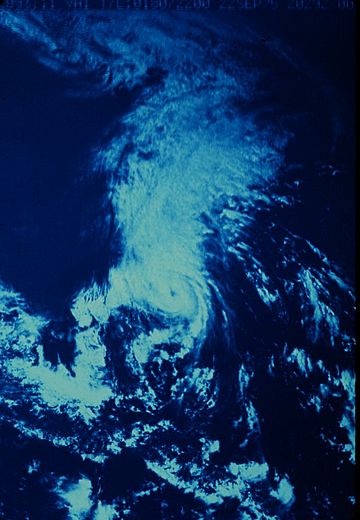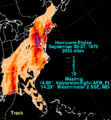Hurricane Eloise facts for kids
| Category 3 major hurricane (SSHWS/NWS) | |

Hurricane Eloise in the Gulf of Mexico before striking Florida
|
|
| Formed | September 13, 1975 |
|---|---|
| Dissipated | September 24, 1975 |
| Highest winds | 1-minute sustained: 125 mph (205 km/h) |
| Lowest pressure | 955 mbar (hPa); 28.2 inHg |
| Fatalities | 80 direct |
| Damage | $560 million (1975 USD) |
| Areas affected | Lesser Antilles, Greater Antilles, Yucatán Peninsula, Florida, Eastern United States |
| Part of the 1975 Atlantic hurricane season | |
Hurricane Eloise was a powerful and damaging storm that hit in September 1975. It caused a lot of destruction across the Caribbean and the U.S.. This hurricane brought strong winds and heavy rain to places like Puerto Rico, Hispaniola (which includes Haiti and the Dominican Republic), and Florida. Eloise was responsible for about 80 deaths and caused around $560 million in damage. Because of how destructive it was, the name 'Eloise' was removed from the list of hurricane names for the Atlantic Ocean.
Contents
How Hurricane Eloise Formed and Grew
Hurricane Eloise started as a tropical wave. This is a low-pressure area that moves across the ocean. It formed near Africa on September 13, 1975. As it moved west, it slowly became stronger.
Journey Through the Caribbean
Eloise first became a tropical depression. This is the first stage of a hurricane. It then grew into a tropical storm on September 16. This happened near the Windward Islands. The storm brought heavy rain and strong winds to islands like Dominica and Guadeloupe.
After passing these islands, Eloise moved over Puerto Rico. It caused major flooding there. Some areas received more than 20 inches (500 mm) of rain. This led to mudslides and damaged many homes.
The storm then moved towards Hispaniola. This island is shared by Haiti and the Dominican Republic. Eloise was still a tropical storm, but it caused more flooding and damage.
Hitting the Yucatán Peninsula
Eloise continued moving west. It entered the Caribbean Sea and then the Gulf of Mexico. On September 20, it hit the Yucatán Peninsula in Mexico. By this time, it was a tropical depression again. It brought heavy rain to the area.
Eloise Becomes a Major Hurricane
After crossing the Yucatán, Eloise moved back over the warm waters of the Gulf of Mexico. This is where it quickly became much stronger. On September 22, Eloise rapidly turned into a hurricane.
Striking Florida as a Category 3 Storm
Eloise gained a lot of power very quickly. In just 24 hours, it went from a tropical depression to a major hurricane. It reached its strongest point just before hitting Florida.
On September 23, Hurricane Eloise made landfall in northwest Florida. It hit near Panama City. At this time, its winds were about 125 miles per hour (205 km/h). This made it a Category 3 hurricane on the Saffir–Simpson Hurricane Scale. A Category 3 storm is considered a major hurricane.
Damage in Florida
The hurricane caused huge damage along the Florida Panhandle. Strong winds destroyed many buildings. The storm surge was also very high. This is when the ocean water is pushed onto land by the storm. The surge reached up to 16 feet (4.9 meters) in some places.
Many beach houses were completely washed away. Roads were damaged, and power lines were knocked down. The total damage in Florida was very high.
After Florida: Moving Inland
After hitting Florida, Eloise moved inland. It quickly weakened into a tropical storm. But it still caused problems as it moved north and east.
Impacts in Other States
Eloise brought heavy rain and flooding to many eastern U.S. states. These included Alabama, Georgia, Maryland, New Jersey, New York, North Carolina, Pennsylvania, South Carolina, Tennessee, and Virginia.
The storm caused rivers to overflow. This led to more flooding and damage to crops and homes. Even though it was weaker, Eloise still caused significant problems far from the coast.
Why the Name Eloise Was Retired
Because Hurricane Eloise caused so much death and destruction, its name was retired. This means the name 'Eloise' will never be used again for an Atlantic hurricane. This is a way to remember very destructive storms.
Images for kids
See also
 In Spanish: Huracán Eloisa para niños
In Spanish: Huracán Eloisa para niños







